Ijraset Journal For Research in Applied Science and Engineering Technology
- Home / Ijraset
- On This Page
- Abstract
- Introduction
- Conclusion
- References
- Copyright
Autonomous Robot for Hospital Application
Authors: Dr. Prathibha Kiran, Dr. Jagadeesha S, Renukesh K, Rachana K, Venkat Ram N S L V, Hemanth G
DOI Link: https://doi.org/10.22214/ijraset.2024.66015
Certificate: View Certificate
Abstract
In modern healthcare environments, especially during pandemics and critical health events, ensuring effective patient care while minimizing direct human contact has become paramount. This research focuses on the development of an Autonomous Robot for Hospital Application, designed to support healthcare professionals in routine tasks such as patient monitoring, delivery of medicines to wards and prescription of medicines. Equipped with various sensors, the robot monitors vital parameters such as body temperature, spo2 levels, heart rate, ECG, delivers medicines to wards and provide accurate prescriptions for ten general symptoms, including appropriate dosages, reducing the burden on medical staff and ensuring timely patient assistance. The system integrates autonomous navigation with obstacle avoidance, ensuring safe movement through hospital corridors. It also features a user-friendly interface for healthcare workers to interact with the robot effectively. By automating routine tasks and enabling remote patient engagement, this innovative solution enhances operational efficiency, reduces the risk of infection for healthcare workers, and ensures continuous patient care even during emergencies. This paper discusses the system\'s design, implementation, and potential impact, showcasing its contribution to advancing healthcare
Introduction
I. INTRODUCTION
Healthcare systems face immense challenges during pandemics and critical health events, often struggling to balance patient needs with staff availability and safety concerns. Routine tasks like patient monitoring, delivery of medicine to wards and surgical equipments to operation theatre and prescription management place additional burdens on medical professionals, potentially impacting the quality of care. To address these challenges, integrating robotics into healthcare offers a practical solution for improving efficiency and reducing risks.
This research focuses on an Autonomous Robot for Hospital Application, designed to assist healthcare professionals by automating routine tasks and minimizing direct human contact which uses line following algorithm. Unlike conventional systems, the robot operates without reliance on Wi-Fi or voice commands, ensuring reliability in low-connectivity environments. It can monitor vital parameters, navigate hospital corridors autonomously, and provide prescriptions with dosage recommendations for ten general symptoms.
The development of this robot aligns with the growing need for innovative healthcare solutions that prioritize safety, efficiency, and scalability. By enabling remote interactions and automating routine responsibilities, the system not only enhances operational efficiency but also ensures consistent patient care, even in high-pressure situations. This paper explores the design, implementation, and potential impact of this robotic application, offering a significant step toward smarter healthcare solutions.
II. LITERATURE REVIEW
Robotics is revolutionizing healthcare, offering exciting ways to improve patient care and make hospital operations more efficient. Let’s explore some fascinating breakthroughs that are shaping this future:
[1] Sunkari Pradeep et al. (2023) introduced a medical assistant robot powered by IoT. This robot monitored critical health metrics like blood pressure, temperature, and glucose levels, providing real-time updates to healthcare professionals. It helped doctors make faster, more informed decisions, but it depended heavily on Wi-Fi. Unfortunately, that meant it wasn’t as effective in areas with poor internet access—an important reminder of the need for robust infrastructure alongside cutting-edge technology.
[2] Thrupti Prakash et al. (2022) created a robot that could navigate hospitals autonomously, using sensors, robotic vision, and obstacle detection to get around. It took on tasks like patient monitoring and handling logistics, making life a lot easier for hospital staff. However, integrating it with existing hospital systems wasn’t always straightforward, showing that even the smartest robots need to fit into the bigger picture.
[3] Pavan Kumar et al. (2021) designed a medication delivery robot that could interact with patients through voice commands. While it was great at engaging patients and making the process more personal, it had trouble in noisy environments or with patients who couldn’t speak. This pointed to the need for robots that can adapt to different communication styles and settings.
[4] Deepa R. (2020) focused on elderly care with a robot that could detect falls and monitor vital signs. It was a lifesaver for older patients but wasn’t versatile enough for broader hospital applications. This study showed the value of specialized robotics while reminding us of the need for designs that can work in a variety of healthcare settings.
[5] Mehta and Patel (2019) proposed a robot that used RFID technology to deliver medications. It was accurate and helped reduce errors, but it required costly infrastructure upgrades, which made it harder for resource-strapped hospitals to adopt.
[6] Karthik et al. (2018) came up with a robotic nurse that monitored patients in real-time and sent out emergency alerts when needed. It was especially helpful in critical care, but because it relied so much on operator input, it wasn’t as autonomous as it could have been. This highlighted the importance of creating robots that can function independently, especially in high-pressure situations.
[7] Rahman et al. (2017) developed a health-assistant robot that could monitor patients’ vital signs and dispense medications based on their needs. It aimed to reduce medical errors and improve care, but its high cost made it less accessible for widespread use. This reinforced the need for more cost-effective robotic solutions in healthcare.
[8] Nair et al. (2016) took a different approach by designing a robot to handle hospital logistics, like delivering supplies and keeping things clean. It made hospitals more efficient and hygienic, but since it couldn’t interact with patients, its impact on direct patient care was limited.
[9] These studies give us a glimpse into the incredible potential of robotics in healthcare. From making real-time health monitoring easier to taking on logistical tasks, robots are stepping up to transform the way hospitals function. However, challenges like cost, integration, and adaptability remain. As we refine these technologies, we move closer to a future where robotics can truly revolutionize healthcare for everyone.
[10] S. S. Nayak, A. K. Soni, and D. P. Singh (2021), this paper introduces an IoT-based health monitoring system that utilizes wearable sensors to continuously collect patient data. The integration of smart devices enables real-time monitoring and diagnosis, ensuring timely interventions. The system is designed to enhance patient care through seamless data collection and analysis, offering healthcare professionals actionable insights.
[11] R. S. Shashikala and P. K. Sharma (2022) propose a system leveraging IoT for real-time health monitoring and prescription management. The system provides healthcare professionals with immediate access to patient data, facilitating accurate diagnosis and effective prescription delivery. Its emphasis on efficiency and integration into healthcare workflows demonstrates its potential to improve patient outcomes and streamline medical operations.
[12] S. A. B. L. Raju and V. P. S. N. Reddy (2020) present an autonomous robotic system aimed at monitoring patients and delivering medication in hospital settings. The robot integrates advanced sensors and autonomous navigation to support healthcare professionals in reducing workload and ensuring timely care. This study highlights the system’s potential to revolutionize hospital operations while addressing limitations like scalability and maintenance requirements.
III. METHODOLOGY
The development of the Autonomous Robot for Hospital Application follows a systematic methodology, focusing on the creation of a robot capable of assisting healthcare professionals by remotely monitoring patients, delivering supplies, and automating routine tasks. This methodology integrates various technologies, including sensors, robotics, and embedded systems, to create a reliable and autonomous system that enhances healthcare operations.
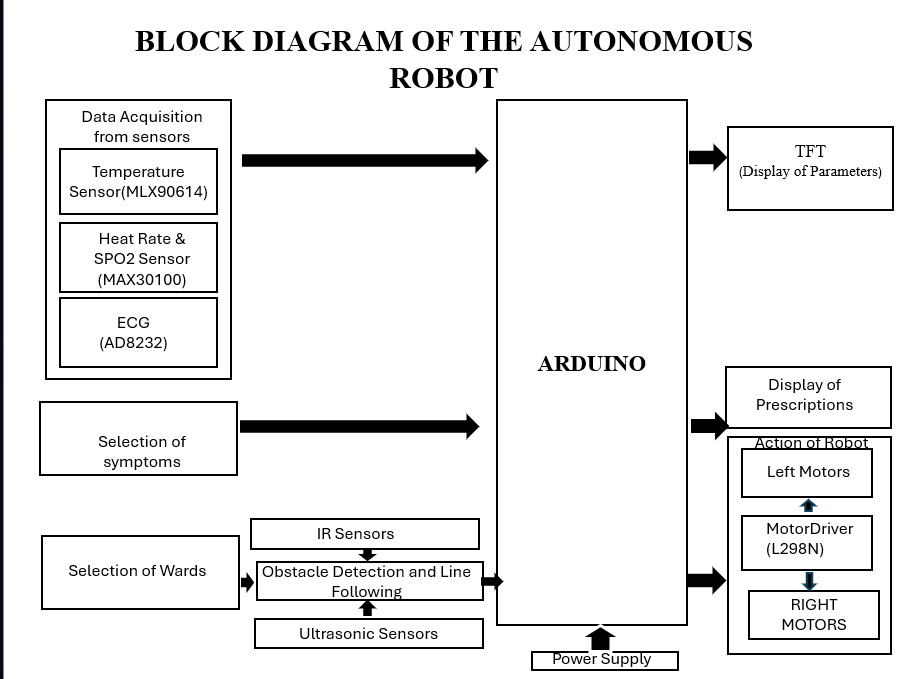
Fig no:1 System architecture
The system architecture is composed of several key components: an Arduino microcontroller, which acts as the brain of the robot, controlling various sensors and actuators; health monitoring sensors, including MAX30100 for heart rate and oxygen saturation, AD8232 for ECG monitoring, and MLX90614 for temperature sensing; a motor driver (L298N) to control the robot's movement; and DC motors and wheels for locomotion. The system is powered by a Lithium-Ion battery, which provides long-lasting power to the robot, making it suitable for hospital use.
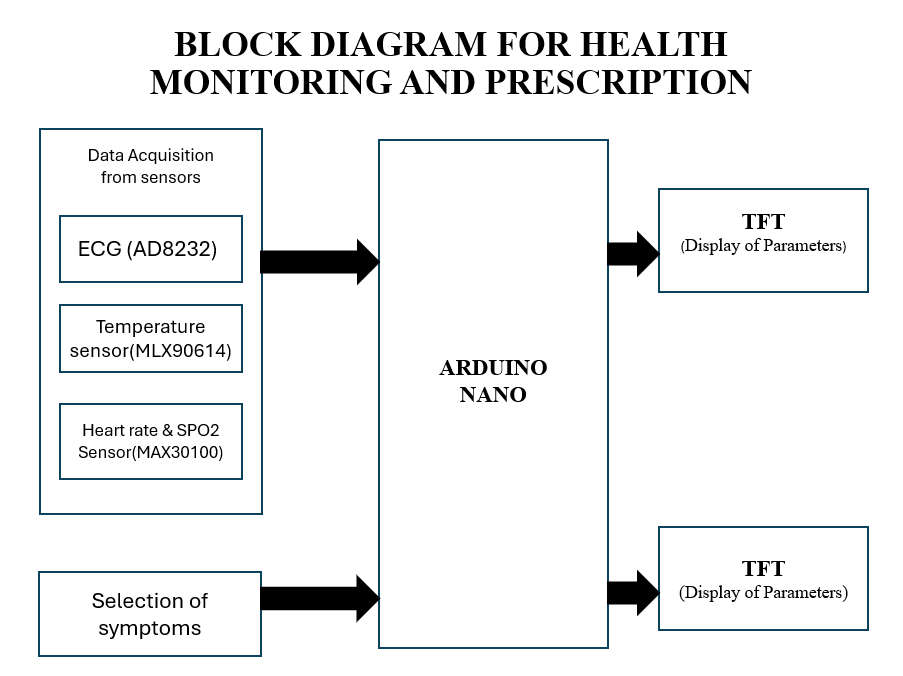
Fig no 2: Block diagram for health monitoring system and prescription
The hardware of the robot involves integrating several components into a cohesive unit. The Arduino microcontroller communicates with the sensors to gather patient data and with the motor driver to control the movement of the robot. The health monitoring sensors collect real-time health data, which is processed by the microcontroller. The motor driver receives commands from the Arduino to control the DC motors, enabling the robot to move autonomously within the hospital. Additionally, castor wheels are used to ensure stability and smooth navigation.
The software component of the system is developed using Arduino IDE (version 2.3.3). The Arduino is programmed to interact with the health sensors and motor driver, processing sensor data and controlling the robot’s movement. The robot autonomously navigates the hospital environment, avoiding obstacles with the help of ultrasonic sensors and making decisions based on the processed health data. The prescriptions include the recommended medication and dosage for ten general symptoms such as fever, headache, nausea, etc. This is achieved through an in-built decision-making algorithm in the Arduino.
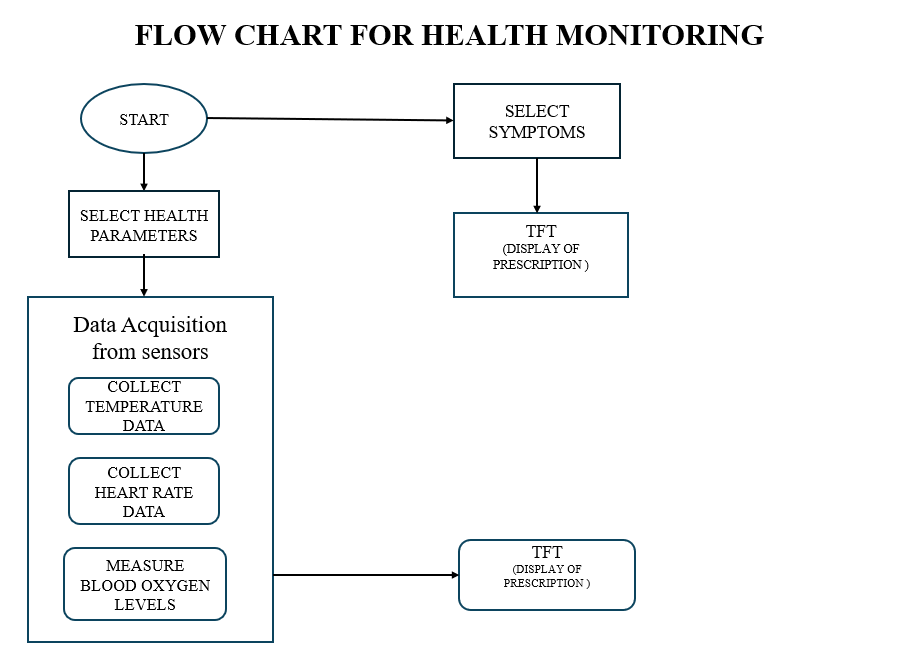
Fig no:3 Flow chart for health monitoring system and prescription
The health data gathered from the sensors is processed locally within the Arduino, which applies predefined algorithms to generate patient status and provide prescriptions. The system uses a local database (stored in the microcontroller) that contains common symptoms and corresponding treatments. Based on the patient’s health data, the system determines the appropriate medication and dosage, offering real-time suggestions.
The system undergoes rigorous testing, including both unit and integration tests. Each sensor is tested for accuracy in reading the patient’s health parameters, and the motor control system is tested to ensure the robot navigates effectively within a hospital environment. Real-life scenarios are simulated to validate the robot’s ability to move autonomously, avoid obstacles, and provide accurate prescriptions. The system is also evaluated for power efficiency and operational endurance, ensuring the battery lasts for extended periods in a hospital setting.
While the proposed system offers a significant leap in autonomous hospital robotics, it has limitations. It does not include voice or Wi-Fi control, which may limit its flexibility in certain scenarios. Furthermore, the system is focused on general symptoms and may need to be expanded to cover more complex conditions. Future improvements may include better integration with existing hospital systems, enhanced patient interaction capabilities, and a broader range of health monitoring sensors
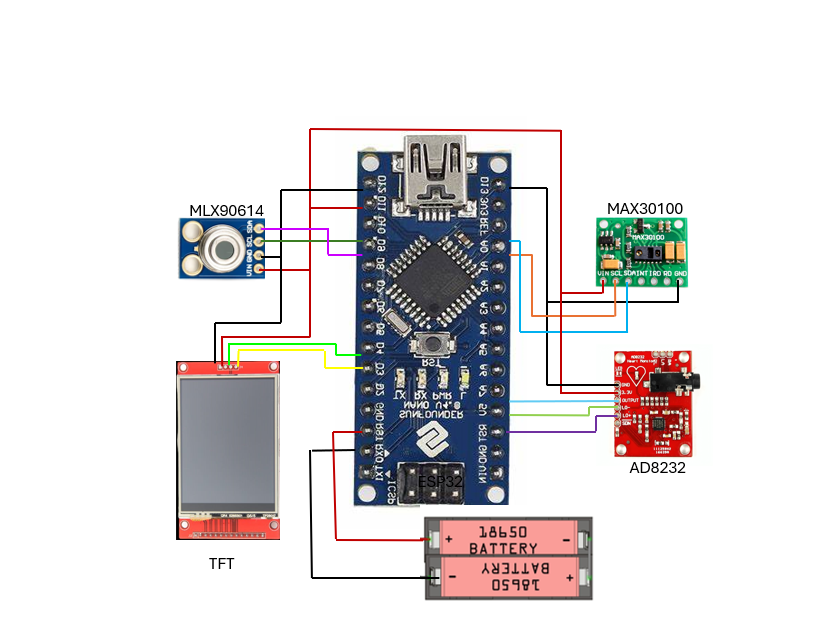
Fig no 4: Circuit diagram for health monitoring system
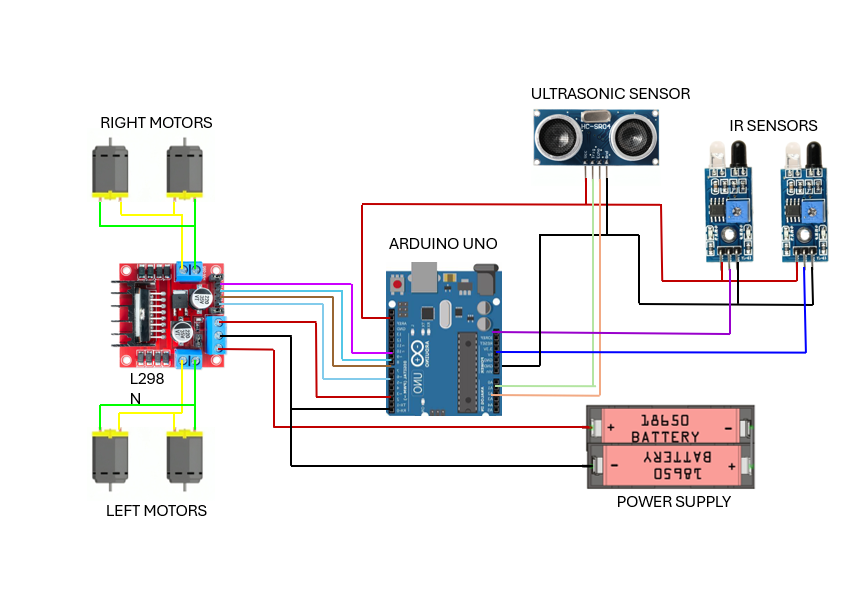
Fig no 5: Circuit diagram for delivery action
IV. RESULTS
The Autonomous Robot for Hospital Application was successfully designed, implemented, and tested to provide healthcare professionals with a reliable tool to monitor patient health, deliver medications, and automate routine tasks. The implementation followed a structured approach, integrating various hardware components, sensors, and embedded systems, and resulted in a system that functions autonomously within a hospital environment. Below is a detailed overview of the results and the implementation process.
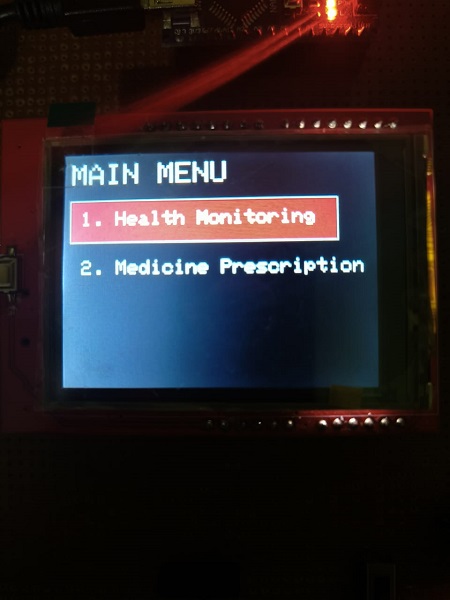
Fig no 6: Health monitoring and medicine on menu
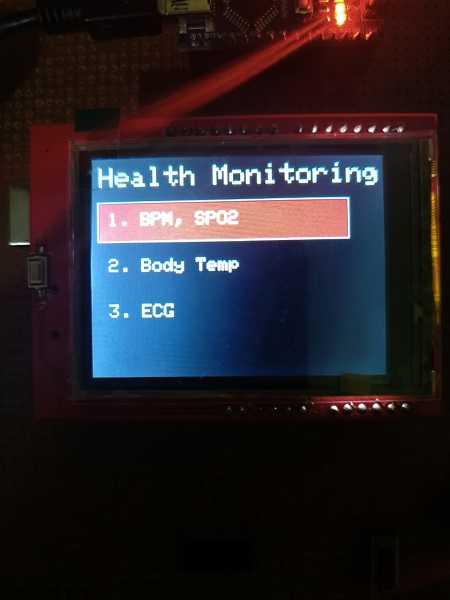
Fig no 7: Health monitoring parameters
The robot successfully monitored key health parameters such as heart rate, body temperature, ECG ,and oxygen saturation using the MAX30100, MLX90614, and AD8232 sensors. These sensors provided real-time, accurate data that was processed by the Arduino microcontroller. The robot’s ability to move autonomously within the hospital environment was tested and validated using ultrasonic sensors for obstacle detection, allowing the robot to navigate safely without collisions. The most notable feature of the system is its ability to generate prescriptions with dosage recommendations for ten common symptoms such as fever, headache, and fatigue. The health monitoring data is displayed on an TFT screen, providing a real-time visual of the patient’s health status. The system does not rely on Wi-Fi for transmitting data, making it adaptable for environments where network connectivity may be an issue. This independence from Wi-Fi ensures that the robot can operate in any hospital area, including those with limited connectivity.
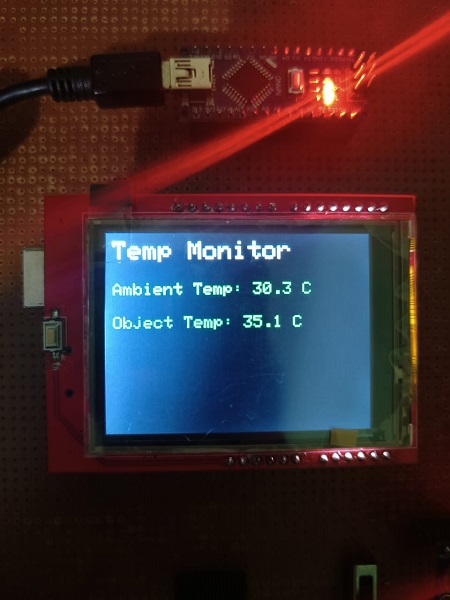
Fig no 8: Temperature monitor
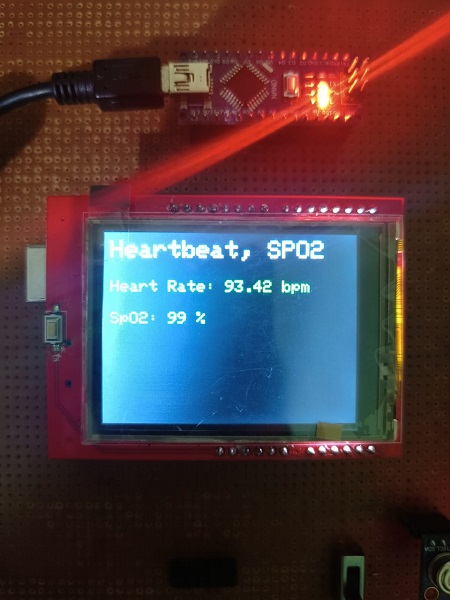
Fig no 9: Heartrate,SPO2 monitor
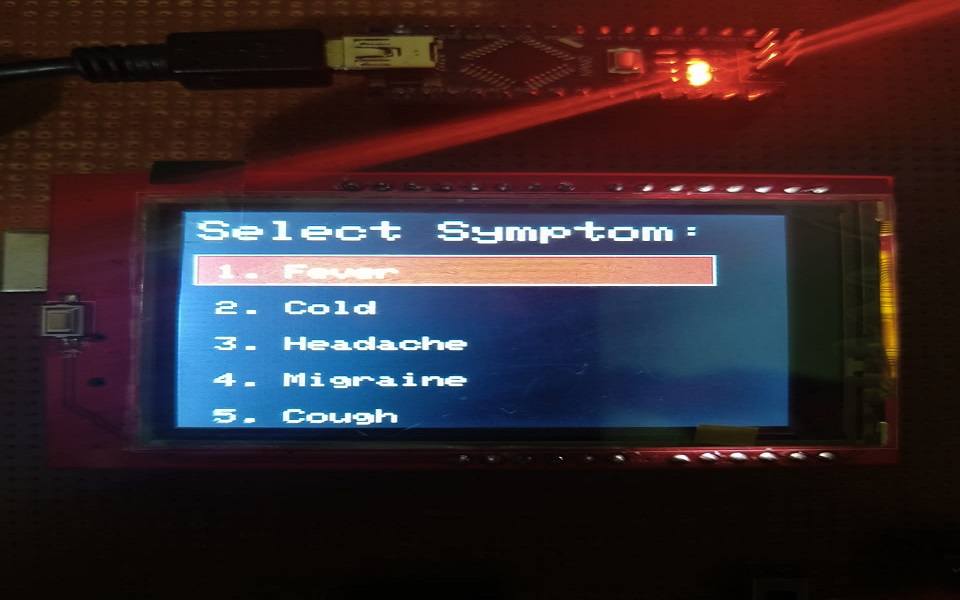
Fig no 10: Selecting symptoms for prescription
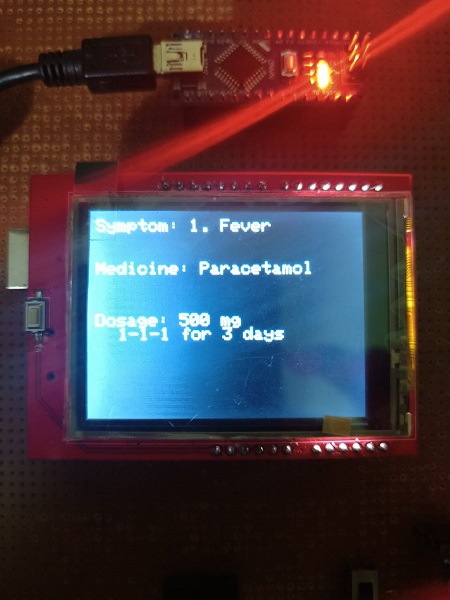
Fig no 11: Medicine prescription
The robot's navigation system was a critical aspect of its design. The DC motors and L298N motor driver enabled smooth and precise movement, allowing the robot to navigate through hospital corridors, rooms, and obstacles. Castor wheels were used for added stability, ensuring the robot could turn and pivot effectively, especially in tight spaces. The system successfully avoided obstacles using the ultrasonic sensors, which detected objects in the robot's path and triggered appropriate steering actions.
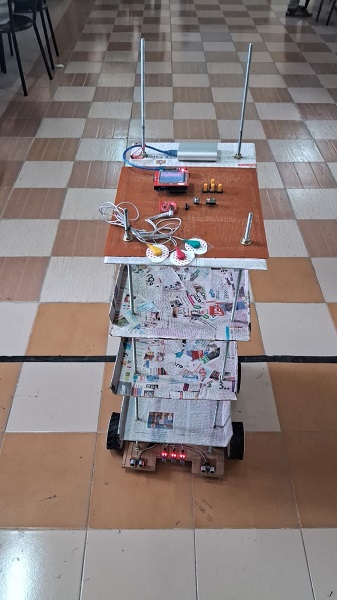
Fig no 12: Autonomous robot for hospital application

Fig no 13: Top view of robot depicting the health monitoring system
The robot was powered by a Lithium-Ion battery, which provided sufficient operational time. During testing, the robot successfully ran for several hours, performing patient monitoring tasks and autonomous navigation without any noticeable power depletion. The system’s power efficiency was an essential aspect, especially in a hospital setting, where frequent recharging of the device could disrupt operations.
The robot was designed with a simple and intuitive user interface, which allowed healthcare professionals to easily interact with the system. The TFT display provided immediate feedback on patient health data and prescriptions. This functionality ensured that healthcare professionals could access crucial patient data on the go, aiding in quick decision-making.
During the testing phase, a few limitations were observed. The system is highly effective for monitoring basic health parameters and offering prescriptions for common symptoms, but it does not handle complex or rare health conditions.
Additionally, the lack of Wi-Fi or voice command integration limits its flexibility in environments where real-time remote monitoring and voice commands would be beneficial. The system’s ability to respond to dynamic changes in the hospital environment is also dependent on the accuracy of the sensors and the quality of the data they produce.
The Autonomous Robot for Hospital Application successfully met its design goals by providing a reliable, autonomous system capable of assisting healthcare professionals. Its ability to monitor health data and offer prescriptions for general symptoms, while navigating independently within the hospital environment, demonstrated the effectiveness of the system in real-world applications. The robot’s successful implementation in terms of autonomous movement, health monitoring, and prescription generation marks a significant step forward in enhancing healthcare support systems
V. DISCUSSION
The proposed autonomous robotic system for hospital applications addresses the critical need for innovative healthcare solutions, particularly during emergencies like pandemics or outbreaks. The robot’s ability to monitor patient health through sensors such as MAX30100, AD8232, and MLX90614 offers real-time tracking of vital signs like heart rate, blood pressure, and body temperature. This functionality aids healthcare professionals in delivering timely interventions.
The inclusion of a prescription system for ten common symptoms adds a unique dimension to the robot’s utility. This feature provides patients with personalized medicine recommendations and dosage instructions, reducing the burden on medical staff and minimizing the risk of prescription errors. By automating routine tasks such as health monitoring, patient interaction, and supply delivery, the robot enhances operational efficiency and allows healthcare workers to focus on critical medical procedures.
Despite its numerous advantages, the system has certain limitations. For instance, its reliance on battery-powered operation requires efficient power management to ensure uninterrupted functionality. Additionally, the absence of voice commands might limit usability for some users who are more accustomed to voice-controlled devices. However, these constraints are mitigated by the robot’s emphasis on robust functionality, such as autonomous navigation using ultrasonic sensors, and its ability to operate effectively in constrained environments.
In comparison to existing healthcare robotic systems, which often depend on Wi-Fi for real-time data transmission, the proposed system provides a more practical and accessible solution. This design ensures adaptability in diverse hospital settings, including rural or resource-limited facilities. As a result, this project demonstrates significant potential for improving healthcare delivery and addressing the challenges of patient care in high-stress scenarios. Future enhancements could focus on integrating advanced AI for decision-making, enhanced power management systems, and extended symptom coverage to further expand the robot’s utility.
Conclusion
This autonomous robotic system marks a significant advancement in healthcare by automating routine tasks and offering essential support to medical professionals during emergencies. The integration of advanced sensors allows real-time monitoring of vital health parameters and assists patients by providing prescriptions for common symptoms, effectively reducing the burden on healthcare staff and improving patient care. With autonomous navigation and intelligent obstacle detection, the robot ensures safe and efficient delivery of medicines and surgical equipment. These features enhance both patient safety and operational efficiency in hospital workflows. While the current system is limited by factors such as battery dependency, its performance highlights its potential to transform healthcare services. Future enhancements could focus on addressing current limitations by incorporating better power management, extending sensor capabilities, and integrating artificial intelligence for advanced decision-making and predictive analytics. These improvements would increase the system’s versatility and efficiency, broadening its applicability in diverse healthcare environments. This project demonstrates how robotic technology can elevate healthcare delivery by enhancing accessibility, reducing staff workloads, and ensuring timely and effective care.
References
[1] Sunkari Pradeep, Madduri Laasya Reddy, Miryanam Harika, Nalumachu Kiranmai, Vanamala Aarthi. Development and Testing of an IoT-Based Medical Assistant Robot: A Design for Enhanced Healthcare Support. Published in 2023. [2] Thrupti Prakash, Jayasri B. S, Prakash K. R. Smart Health Monitoring System Using Robotics. Published in 2022. [3] S. K. R. Iyer, G. D. Ravindra, M. R. V. Reddy. Development of an Autonomous Robot for Hospital Assistance. Journal of Robotics and Automation, 2021. [4] S. Gupta, S. Yadav, S. Arora. Design and Implementation of a Healthcare Robot Using IoT for Patient Monitoring. International Journal of Advanced Research in Electrical and Electronics Engineering, 2020. [5] R. Patel, P. K. Gupta. Automated Healthcare System Using Embedded Systems. Journal of Medical Engineering and Technology, 2019. [6] T. M. K. S. Kumar, K. V. R. Rao. Design and Implementation of an Autonomous Robotic System for Healthcare Applications. International Journal of Robotics and Mechatronics, 2018. [7] A. N. K. P. Chatterjee, S. K. Bhattacharya. Smart Healthcare Robots for Elderly Assistance and Monitoring. Journal of Healthcare Engineering, 2020. [8] P. D. Rao, V. S. Kumar, S. R. Tiwari. Robotic Health Monitoring System for Real-Time Patient Data Collection and Management. Proceedings of the IEEE International Conference on Robotics and Automation, 2017. [9] S. S. Nayak, A. K. Soni, and D. P. Singh. IoT-Based Health Monitoring and Control System Using Wearable Sensors and Smart Devices. International Journal of Advanced Computer Science and Applications, 2021. [10] R. S. Shashikala, P. K. Sharma. Real-Time Health Monitoring and Prescription Management System Using IoT. International Journal of Robotics and Automation, 2022. [11] S. A. B. L. Raju, V. P. S. N. Reddy. Development of Autonomous Robotic Systems for Hospital Patient Monitoring and Medication Delivery. International Journal of Medical Robotics and Computer Assisted Surgery, 2020.
Copyright
Copyright © 2024 Dr. Prathibha Kiran, Dr. Jagadeesha S, Renukesh K, Rachana K, Venkat Ram N S L V, Hemanth G. This is an open access article distributed under the Creative Commons Attribution License, which permits unrestricted use, distribution, and reproduction in any medium, provided the original work is properly cited.

Download Paper
Paper Id : IJRASET66015
Publish Date : 2024-12-19
ISSN : 2321-9653
Publisher Name : IJRASET
DOI Link : Click Here
 Submit Paper Online
Submit Paper Online

